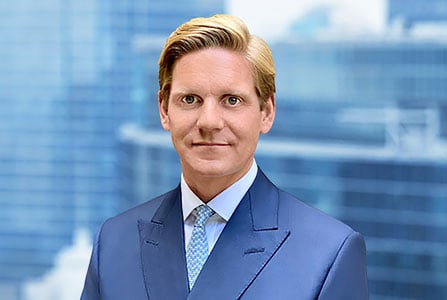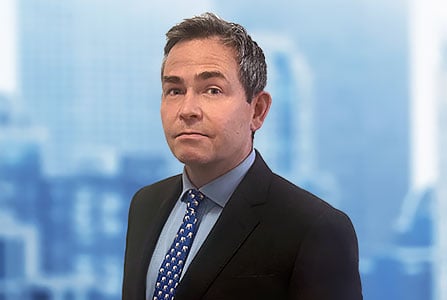March 25, 2025 | Global Equity
Fresh Perspectives on Emerging Markets

We believe emerging markets (EMs) present a landscape of opportunity for equity investors despite macroeconomic headwinds. Below we explain why, discussing our investment approach and what we believe are attractive and unattractive industries in EMs. You can read more in our white paper.
Our Investment Approach
Ian: The approach that we believe suits us is owning leading companies, which we call leaders. We’ve observed that leaders tend to have disproportionate exposure to certain quality-oriented factors, such as sustainable value creation or earnings quality, and we can see empirical evidence for the efficacy of many of these factors over the long term.
We believe the best equity investments tend to be in companies that can positively surprise the market. — Paul Birchenough, Partner
Paul: We believe the best equity investments tend to be in companies that can positively surprise the market with respect to the scale or quality of their earnings, or the amount of time that earnings growth can remain elevated. We have found that it is often, albeit not always, the leading companies that are most likely to achieve this. Especially in EMs, where there are many growth opportunities but also many pitfalls, as well as a high and volatile cost of capital. It’s not hard to see why these sorts of companies have a habit of positively surprising. We look for companies with a healthy backdrop for growth, sustainable competitive advantages, and capable management that can inspire excellence and make good strategic decisions.
Ian: So, we like to own leading companies. But we also like to buy them when we believe their potential is not sufficiently discounted by the market, and ideally when their leadership is widening as opposed to narrowing.
Defining Leaders
Paul: I think the traits of an exceptional company can be summed up in a few key pillars.
First, there’s the idea of a win-win proposition. This means creating value for everyone involved—selling a product at a fair price and ensuring that everyone in the supply chain benefits. It’s the Costco model: when you treat everyone fairly, you get a flywheel effect with repeat customers.
The second pillar is competitive advantage. This is about building strong “moats,” whether from brands, human capital, or lowest cost, to secure a lasting position in the market. Then there’s the growth runway. Exceptional companies have sustainable growth tailwinds over the long term, whether that’s from expanding customer bases in places like India, increased penetration in EMs, or consolidating their industry.
Finally, quality management is crucial, as mentioned earlier. This means disciplined capital allocation, alignment with us as minority shareholders, integrity, and a winning culture. And it includes clean accounting—a history of transparency.
These traits define a company that’s built to lead.
We want to own companies that we believe will be the leaders in three to five years, not just today. — Ian Smith, Partner
Ian: We also want to own companies that we believe will be the leaders in three to five years, not just today. On the one hand, we’re trying to identify the sustainable leaders of today. On the other, we’re also trying to unearth the future leaders of tomorrow. This thinking also helps us to avoid the companies that are at risk of losing their leadership status.
Attractive Industries
Paul: We’ve typically had significant exposure to the technology and consumer sectors. Whether it’s a bar of soap or a cutting-edge semiconductor, these products deliver strong value at fair prices. In places like Taiwan, South Korea, and India, we find companies in these sectors with high, sustainable competitive advantages, from tech leaders to century-old brands that have built customer trust.
We believe technology offers a clear growth runway, especially in segments driving major shifts like artificial intelligence (AI)—what Jensen Huang, the CEO and co-founder of NVIDIA, calls an “Industrial Revolution” in tech. Companies aligned with these mega trends enjoy substantial growth support.
On the consumption side, EMs with rising gross domestic product (GDP) per capita, such as India and Indonesia, enable growth through deeper market penetration, industry consolidation, and premiumization. As incomes rise, consumers in fragmented markets shift to trusted brands, and even within brands, they “trade up” to premium options—from basic washing powder to advanced liquid capsules.
We look for industries where bargaining power over customers or suppliers can be sustained and growth tailwinds amplify compounding potential. — Ian Smith, Partner
Ian: That said, all industries have the potential to be attractive. We look for those where bargaining power over customers or suppliers can be sustained and growth tailwinds amplify compounding potential. Our framework seeks to identify sources of this power—whether through niche market dominance, strong brands, unique intellectual property, or scale advantages.
We’re interested in any industry with these qualities and a durable growth opportunity. But we really value companies that can strengthen these advantages over time through superior management and corporate culture.
Unattractive Industries
Ian: We don’t rule out any industries because industries can change or improve. Right now, though, there are several areas in which we would struggle to invest. In many EMs, banks operate in saturated, fragmented, and heavily regulated financial systems, limiting their potential for sustainable value creation. Mining often faces flat cost curves, which coupled with weak demand can lead to disappointing returns. Healthcare also poses potential challenges due to regulatory risks.
Historically, we’ve had lower exposure to commodity industries, such as oil and materials. — Paul Birchenough, Partner
Paul: Historically, we’ve had lower exposure to commodity industries, such as oil and materials, where businesses generally lack pricing power and sustainable competitive advantages. In EMs, these sectors often have ties to government ownership, which can complicate governance and minority ownership alignment. While we don’t entirely rule out these industries and can find high-quality leaders within them, we tend to find fewer opportunities there.
Ian: We also generally avoid capital-intensive industries with few barriers to competition, where there is no way to stop competitors going head-to-head. Examples are telcos and airlines, though there are exceptions. That said, we appreciate that capital intensity can also act as a barrier to entry, so we don’t rule out such industries in which a company’s industry dominance allows high returns on capital to be achieved. For example, we own a leading airline in India that emerged from COVID in a very strong competitive position. And there is a well-known Taiwanese semiconductor company that has been able to deter competition; it might be the poster child for capital intensity.
Opportunities
Ian: There are, as ever, many excellent growth companies in EMs trading below their intrinsic value. We believe our strategy holds a good share of these undervalued companies.
Several trends are well-recognized, including the buildout of AI infrastructure, investment needs in power and grid systems, and India’s continued economic development. We’re still in the early stages of some of these trends—AI is just beginning to scale, and India still comprises less than 4% of global GDP. Yet, there is a clear risk that much of this future potential is already priced in, and so we stay disciplined, focusing on areas where we believe the risk/reward balance remains favorable.
Within consumer sectors, we currently favor experience-oriented products and services, such as travel, food, leisure, and beauty. These areas remain underpenetrated in mature markets such as China, and we anticipate higher growth rates in less developed countries, such as India, when the socioeconomic bell curve shifts to the right.
The global energy transition is a key area of focus for us. — Paul Birchenough, Partner
Paul: While energy transition companies have faced recent challenges due to cyclical pressures, we see potential driven by several forces.
Government policies and decreasing costs have driven higher electrical vehicle (EV) adoption, and that’s going to put more burden on the grid and require energy storage solutions.
The growth of AI is also intensifying power needs, as data centers and AI applications require substantial energy.
We’re also seeing policy shifts worldwide toward renewables like wind and solar, which are becoming cost-competitive with traditional coal and gas.
Finally, much of the developed world’s energy infrastructure is overdue for replacement, with over 50% of the grid in the European Union and United States exceeding 20 years in age.
Macro and Geopolitical Drivers in EMs
Paul: We believe we should not ignore the macro environment when investing in EMs. We take a medium- to long-term approach to incorporating macroeconomics into the forecasts and discount rates that drive our investment models. An appreciation for structural versus transient macro drivers can also help us to better understand whether low headline valuations within a country can present an opportunity or not.
Ian: We seek companies with high pricing power and strong balance sheets, and often net cash. When we do see volatility stemming from changes in macroeconomic and geopolitical volatility—whether from inflation or currency shifts—these companies can generally navigate it. For example, they have the pricing power to pass on inflation that passes through from currency weakness, and with strong internal cash flows, they can fund growth without relying on debt or equity markets.
Monetary Policy
Ian: The U.S. dollar’s role as the global reserve currency makes U.S. monetary and fiscal policy crucial for EM returns. U.S. rates effectively set the global risk-free rate and the tone for global liquidity conditions.
Since 1987, there have been two prolonged periods of EM outperformance and two prolonged periods of EM underperformance, with the longest underperformance stretching from October 2010 through today. The common denominator in these periods has been the dollar. A rising dollar is bad for EM equities, while a stable or falling dollar benefits them.
Some investments are more sensitive to developed-market macroeconomic and rate cycles than others, but we seek to hold companies with healthier balance sheets (particularly regarding dollar debt) and strong market positioning, which provide resilience in challenging macro environments.
On Volatility
Paul: EM portfolio managers are often presented with extreme volatility, sometimes driven by politics or regulation. It can be rewarding to astutely judge risk/reward in these moments—deciding whether to sell or buy more of a stock that has already fallen heavily, judging the difference between a cycle and an ongoing structural decline, and differentiating between a durable trend and a fad. These decisions aren’t easy. We follow some rules to help guide our decision-making, but you’ll never escape the need for good judgment.
On Valuation Discipline
Ian: Valuation discipline is crucial—a lesson reinforced in 2022. While we don’t believe we need to anchor to low P/E ratios or a value factor, we aim to avoid buying companies for more than they are worth.
Paul: We take a long-term view, putting less emphasis on shorter-term P/E ratios, as we believe they often fail to reflect a company’s true intrinsic value and risks.
Ian: We start to get interested in companies when their internal rates of return (IRRs) exceed our threshold. However, portfolio construction balances multiple objectives. We need to weigh the IRR potential of companies against other considerations around company quality, tail risks, portfolio guidelines, and overall portfolio risk factors. Fortunately, as portfolio managers we have various resources at our disposal to help with the complex task of balancing these different, sometimes competing objectives.
Paul Birchenough, partner, is director of research and a portfolio manager on William Blair’s global equity team.
Ian Smith, partner, is a portfolio manager on William Blair’s global equity team.


